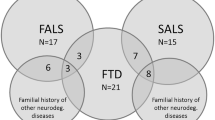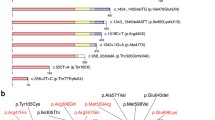Abstract
Amyotrophic lateral sclerosis (ALS) is a neurodegenerative disorder affecting upper motor neurons in the brain and lower motor neurons in the brain stem and spinal cord, resulting in fatal paralysis. It has been found to be associated with frontotemporal lobar degeneration (FTLD). In the present study, we have described homozygosity mapping and gene sequencing in a consanguineous autosomal recessive Pakistani family showing non-juvenile ALS without signs of FTLD. Gene mapping was carried out in all recruited family members using microsatellite markers, and linkage was established with sigma non-opioid intracellular receptor 1 (SIGMAR1) gene at chromosome 9p13.2. Gene sequencing of SIGMAR1 revealed a novel 3′-UTR nucleotide variation c.672*31A>G (rs4879809) segregating with disease in this family. The C9ORF72 repeat region in intron 1, previously implicated in a related phenotype, was excluded through linkage, and further confirmation of exclusion was obtained by amplifying intron 1 of C9ORF72 with multiple primers in affected individuals and controls. In silico analysis was carried out to explore the possible role of 3′-UTR variant of SIGMAR1 in ALS. The Regulatory RNA motif and Element Finder program revealed disturbance in miRNA (hsa-miR-1205) binding site due to this variation. ESEFinder analysis showed new SRSF1 and SRSF1-IgM-BRCA1 binding sites with significant scores due to this variation. Our results indicate that the 3′-UTR SIGMAR1 variant c.672*31A>G may have a role in the pathogenesis of ALS in this family.





Similar content being viewed by others
References
Burrell JR, Kiernan MC, Vucic S, Hodges JR (2011) Motor neuron dysfunction in frontotemporal dementia. Brain 134:2582–2594
Fecto F, Siddique T (2011) SIGMAR1 mutations, genetic heterogeneity at the chromosome 9p locus, and the expanding etiological diversity of amyotrophic lateral sclerosis. Ann Neurol 70:867–870
Byrne S, Walsh C, Lynch C et al (2011) Rate of familial amyotrophic lateral sclerosis: a systematic review and meta-analysis. J Neurol Neurosurg Psychiatry 82:623–627
Millecamps S, Salachas F, Cazeneuve C et al (2010) SOD1, ANG, VAPB, TARDBP, and FUS mutations in familial amyotrophic lateral sclerosis: genotype-phenotype correlations. J Med Genet 47:554–560
Renton AE, Chiò A, Traynor BJ (2014) State of play in amyotrophic lateral sclerosis genetics. Nat Neurosci 17:17–23
van Es MA, Dahlberg C, Birve A, Veldink JH, van den Berg LH, Andersen PM (2010) Large scale SOD1 mutation screening provides evidence for genetic heterogeneity in amyotrophic lateral sclerosis. J Neurol Neurosurg Psychiatry 81:562–566
Kwiatkowski TJ Jr, Bosco DA, Leclerc AL et al (2009) Mutations in the FUS/TLS gene on chromosome 16 cause familial amyotrophic lateral sclerosis. Science 323:1205–1208
Majounie E, Renton AE, Mok K et al (2012) Frequency of the C9orf72 hexanucleotide repeat expansion in patients with amyotrophic lateral sclerosis and frontotemporal dementia: a cross-sectional study. Lancet Neurol 11:323–330
Tagashira H, Shinoda Y, Shioda N, Fukunaga K (2014) Methyl pyruvate rescues mitochondrial damage caused by SIGMAR1 mutation related to amyotrophic lateral sclerosis. Biochim Biophys Acta 1840:3320–3334
Su XW, Broach JR, Connor JR, Gerhard GS, Simmons Z (2014) Genetic heterogeneity of amyotrophic lateral sclerosis: implications for clinical practice and research. Muscle Nerve 49:786–803
Luty AA, Kwok JB, Dobson-Stone C et al (2010) Sigma nonopioid intracellular receptor 1 mutations cause frontotemporal lobar degeneration-motor neuron disease. Ann Neurol 68:639–649
Hayashi T, Su TP (2007) Sigma-1 receptor chaperones at the ER-mitochondrion interface regulate Ca (2+) signaling and cell survival. Cell 131:596–610
Shioda N, Ishikawa K, Tagashira H, Ishizuka T, Yawo H, Fukunaga K (2012) Expression of a truncated form of the endoplasmic reticulum chaperone protein, σ1 receptor, promotes mitochondrial energy depletion and apoptosis. J Biol Chem 287:23318–23331
Mavlyutov TA, Epstein ML, Andersen KA, Ziskind-Conhaim L, Ruoho AE (2010) The sigma-1 receptor is enriched in postsynaptic sites of C-terminals in mouse motoneurons. An anatomical and behavioral study. Neurosci 167:247–255
Morita M, Al-Chalabi A, Andersen PM et al (2006) A locus on chromosome 9p confers susceptibility to ALS and frontotemporal dementia. Neurology 66:839–844
Belzil VV, Daoud H, Camu W, Strong MJ, Dion PA, Rouleau GA (2013) Genetic analysis of SIGMAR1 as a cause of familial ALS with dementia. Eur J Hum Genet 21:237–239
Renton AE, Majounie E, Waite A et al (2011) A hexanucleotide repeat expansion in C9ORF72 is the cause of chromosome 9p21-linked ALS-FTD. Neuron 72:257–268
DeJesus-Hernandez M, Mackenzie IR, Boeve BF et al (2011) Expanded GGGGCC hexanucleotide repeat in noncoding region of C9ORF72 causes chromosome 9p-linked FTD and ALS. Neuron 72:245–256
Kim C, Lee HC, Sung JJ (2014) Amyotrophic lateral sclerosis—cell based therapy and novel therapeutic development. Exp Neurobiol 23:207–214
Kong X, Murphy K, Raj T, He C, White PS, Matise TC (2004) A combined linkage-physical map of the human genome. Am J Hum Genet 75(6):1143–1148
Hassan MJ, Chishti MS, Jamal SM, Tariq M, Ahmad W (2008) A syndromic form of autosomal recessive congenital microcephaly (Jawad syndrome) maps to chromosome 18p11.22-q11.2. Hum Genet 123:77–82
Chang TH, Huang HY, Hsu JB, Weng SL, Horng JT, Huang HD (2013) An enhanced computational platform for investigating the roles of regulatory RNA and for identifying functional RNA motifs. BMC bioinformatics 14(2):S4
Al-Saif A, Al-Mohanna F, Bohlega S (2011) A mutation in sigma-1 receptor causes juvenile amyotrophic lateral sclerosis. Ann Neurol 70:913–919
Dobson-Stone C, Luty AA, Thompson EM et al (2013) Frontotemporal dementia-amyotrophic lateral sclerosis syndrome locus on chromosome 16p12.1-q12.2: genetic, clinical and neuropathological analysis. Acta Neuropathol 125(4):523–533
Acknowledgments
We are grateful to the family members for cooperating in the research process.
Conflict of interest
All authors declare no competing interests.
Author information
Authors and Affiliations
Corresponding author
Electronic supplementary materials
Below is the link to the electronic supplementary material.
Supplementary Table 1
(XLS 19 kb)
Rights and permissions
About this article
Cite this article
Ullah, M.I., Ahmad, A., Raza, S.I. et al. In silico analysis of SIGMAR1 variant (rs4879809) segregating in a consanguineous Pakistani family showing amyotrophic lateral sclerosis without frontotemporal lobar dementia. Neurogenetics 16, 299–306 (2015). https://doi.org/10.1007/s10048-015-0453-1
Received:
Accepted:
Published:
Issue Date:
DOI: https://doi.org/10.1007/s10048-015-0453-1




